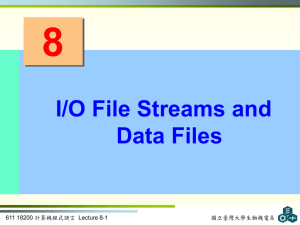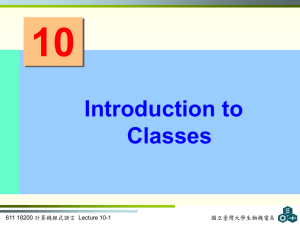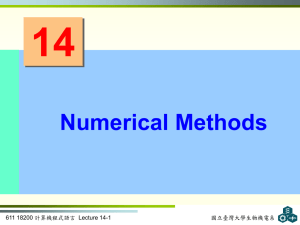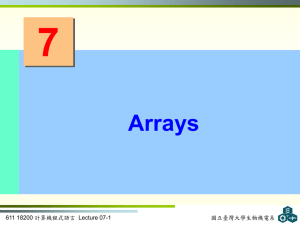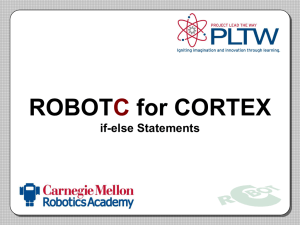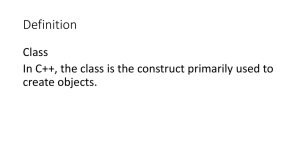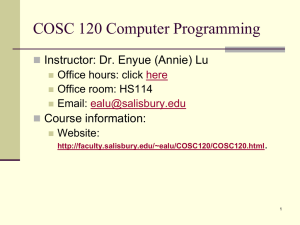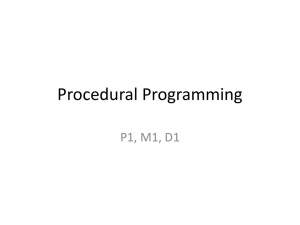if-else
advertisement
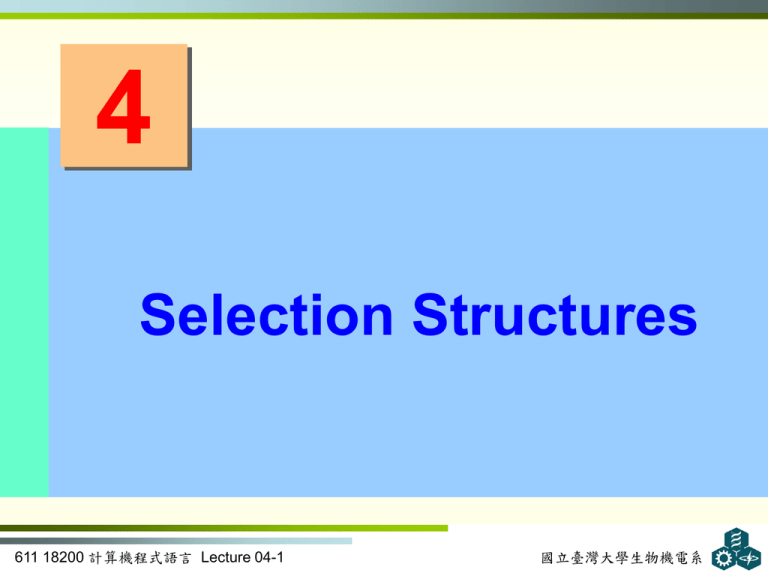
4
Selection Structures
611 18200 計算機程式語言 Lecture 04-1
國立臺灣大學生物機電系
Contents
•
•
•
•
•
•
Selection criteria
The if-else statement
Nested if statements
The switch statement
Program testing
Common programming errors
611 18200 計算機程式語言 Lecture 04-2
國立臺灣大學生物機電系
Selection Criteria
• if-else statement: Implements a decision
structure for two alternatives
Syntax:
if (condition)
statement executed if condition is true;
else
statement executed if condition is false;
611 18200 計算機程式語言 Lecture 04-3
國立臺灣大學生物機電系
Selection Criteria
• The condition is evaluated to its numerical
value:
– A non-zero value is considered to be true
– A zero value is considered to be false
• The else portion is optional; it is executed only
if the condition is false
• The condition may be any valid C++ expression
611 18200 計算機程式語言 Lecture 04-4
國立臺灣大學生物機電系
Relational Operators
• Relational expression: Compares two
operands or expressions using relational
operators
Table 4.1 C++’s Relational Operators
611 18200 計算機程式語言 Lecture 04-5
國立臺灣大學生物機電系
Relational Operators
• Relational expressions are evaluated to a
numerical value of 1 or 0 only:
– If the value is 1, the expression is true
– If the value is 0, the expression is false
• char values are automatically coerced to int
values for comparison purposes
• Strings are compared on a character by
character basis
– The string with the first lower character is
considered smaller
611 18200 計算機程式語言 Lecture 04-6
國立臺灣大學生物機電系
Relational Operators
• Examples of string comparisons
611 18200 計算機程式語言 Lecture 04-7
國立臺灣大學生物機電系
Logical Operators
• AND (&&): Condition is true only if both
expressions are true
• OR (||): Condition is true if either one or both of
the expressions is true
• NOT (!): Changes an expression to its opposite
state; true becomes false, false becomes true
611 18200 計算機程式語言 Lecture 04-8
國立臺灣大學生物機電系
Logical Operators
Table 4.2 Operator Precedence and Associativity
611 18200 計算機程式語言 Lecture 04-9
國立臺灣大學生物機電系
A Numerical Accuracy Problem
• Comparing single and double precision values for
equality (==) can lead to errors because values
are stored in binary
• Instead, test that the absolute value of the
difference is within an acceptable range
– Example:
abs(operandOne – operandTwo) < 0.000001
611 18200 計算機程式語言 Lecture 04-10
國立臺灣大學生物機電系
The if-else Statement
•
•
•
if-else performs instructions based on the
result of a comparison
Place statements on separate lines for
readability
Syntax:
611 18200 計算機程式語言 Lecture 04-11
國立臺灣大學生物機電系
The if-else Statement
Figure 4.2 The if-else flowchart
611 18200 計算機程式語言 Lecture 04-12
國立臺灣大學生物機電系
The if-else Statement
Program 4.1
#include <iostream>
#include <cmath>
using namespace std;
int main()
{
double radius;
cout << "Please type in the radius: ";
cin >> radius;
if (radius < 0.0)
cout << "A negative radius is invalid" << endl;
else
cout << "The area of this circle is "
<< 3.1416 * pow(radius,2) << endl;
return 0;
}
611 18200 計算機程式語言 Lecture 04-13
國立臺灣大學生物機電系
The if-else Statement
The Output from the Program 4.1
Please type in the radius: -2.5
A negative radius is invalid
Please type in the radius: 2.5
The area of this circle is 19.635
611 18200 計算機程式語言 Lecture 04-14
國立臺灣大學生物機電系
Compound Statements
• Compound statement: A sequence of single
statements contained between braces
– Creates a block of statements
• Block of statements can be used anywhere that
a single statement is legal
• Any variable declared within a block is usable
only within that block
• Scope: The area within a program where a
variable can be used
– A variable’s scope is based on where the
variable is declared
611 18200 計算機程式語言 Lecture 04-15
國立臺灣大學生物機電系
Block Scope
• Statements contained in compound statement
are a single block of code
• Scope of the variable: Area in a program
where a variable can be used
611 18200 計算機程式語言 Lecture 04-16
國立臺灣大學生物機電系
Block Scope
Example with Two Blocks of Code
{ // start of outer block
int a = 25;
int b = 17;
cout << “The value of a is ” << a << “ and b is ” << b << endl;
{ // start of inner block
double a = 46.25;
int c = 10;
cout << “a is now ” << a
<< “ b is now ” << b
<< “ and c is ” << c << endl;
} // end of inner block
cout << “a is now ” << a << “ and b is ” << b << endl;
} // end of outer block
The Output from the Example
The value of a is 25 and b is 17
a is now 46.25 b is now 17 and c is 10
a is now 25 and b is 17
611 18200 計算機程式語言 Lecture 04-17
國立臺灣大學生物機電系
One-Way Selection
• One-way selection: An if
statement without the
optional else portion
Figure 4.3 A one-way selection if statement
611 18200 計算機程式語言 Lecture 04-18
國立臺灣大學生物機電系
Problems Associated with the ifelse Statement
• Common problems with if-else
statements:
– Misunderstanding what an expression is
– Using the assignment operator (=) instead of
the relational operator (==)
611 18200 計算機程式語言 Lecture 04-19
國立臺灣大學生物機電系
Nested if Statements
• if-else statement can contain any valid C++
statement, including another if-else
• Nested if statement: an if-else statement
completely contained within another if-else
• Use braces to block code, especially when
inner if statement does not have its own
else
611 18200 計算機程式語言 Lecture 04-20
國立臺灣大學生物機電系
Nested if Statements
Figure 4.4a Nested within the if part
611 18200 計算機程式語言 Lecture 04-21
國立臺灣大學生物機電系
The if-else Chain
• if-else chain: A nested if statement
occurring in the else clause of the outer ifelse
• If any condition is true, the corresponding
statement is executed and the chain terminates
• Final else is only executed if no conditions
were true
– Serves as a catch-all case
• if-else chain provides one selection from
many possible alternatives
611 18200 計算機程式語言 Lecture 04-22
國立臺灣大學生物機電系
The if-else Chain
Figure 4.4b Nested within the else part
611 18200 計算機程式語言 Lecture 04-23
國立臺灣大學生物機電系
The if-else Chain
• General form of an if-else chain
if (expression_1)
statement1;
else if (expression_2)
statement2;
else if (expression_3)
statement3;
.
.
.
else if (expression_n)
statement_n;
else
last_statement;
611 18200 計算機程式語言 Lecture 04-24
國立臺灣大學生物機電系
The if-else Chain
Program 4.5
#include <iostream>
using namespace std;
int main()
{
char code;
cout << "Enter a specification code: ";
cin >> code;
if (code == 'S')
cout << "The item is space exploration grade.";
else if (code == 'M')
cout << "The item is military grade.";
else if (code == 'C')
cout << "The item is commercial grade.";
else if (code == 'T')
cout << "The item is toy grade.";
else
cout << "An invalid code was entered.";
cout << endl;
return 0;
}
611 18200 計算機程式語言 Lecture 04-25
國立臺灣大學生物機電系
The switch Statement
• Format:
switch (expression)
{
// start of compound statement
case value_1:
<- terminated with a colon
statement1;
statement2;
break;
case value_2:
<- terminated with a colon
statementm;
break;
default:
<- terminated with a colon
statementaa;
}
// end of switch and compound
// statement
611 18200 計算機程式語言 Lecture 04-26
國立臺灣大學生物機電系
The switch Statement
• switch statement: Provides for one selection
from many alternatives
• switch keyword starts the statement
– Is followed by the expression to be evaluated
• case keyword identifies a value to be compared
to the switch expression
– When a match is found, statements in this case
block are executed
• All further cases after a match is found are
executed unless a break statement is found
611 18200 計算機程式語言 Lecture 04-27
國立臺灣大學生物機電系
The switch Statement
• default case is executed if no other case
value matches were found
• default case is optional
611 18200 計算機程式語言 Lecture 04-28
國立臺灣大學生物機電系
The switch Statement
Program 4.6
#include <iostream>
using namespace std;
int main()
{
int opselect;
double fnum, snum;
cout
cin
cout
cout
cout
cout
cin
<<
>>
<<
<<
<<
<<
>>
"Please type in two numbers: ";
fnum >> snum;
"Enter a select code: ";
"\n
1 for addition";
"\n
2 for multiplication";
"\n
3 for division : ";
opselect;
611 18200 計算機程式語言 Lecture 04-29
國立臺灣大學生物機電系
The switch Statement
Program 4.6 (Continued)
switch (opselect)
{
case 1:
cout << "The sum of the numbers entered is " << fnum+snum
<< endl;
break;
case 2:
cout << "The product of the numbers entered is "
<< fnum*snum << endl;
break;
case 3:
cout << "The first number divided by the second is "
<< fnum/snum << endl;
break;
}
// end of switch
return 0;
} // end of main()
611 18200 計算機程式語言 Lecture 04-30
國立臺灣大學生物機電系
The switch Statement
The Output from Program 4.6
Please type in two numbers: 12 3
Enter a select code:
1 for addition
2 for multiplication
3 for division : 2
The product of the numbers entered is 36
OR
Please type in two numbers: 12 3
Enter a select code:
1 for addition
2 for multiplication
3 for division : 3
The first number divided by the second is 4
611 18200 計算機程式語言 Lecture 04-31
國立臺灣大學生物機電系
A Case Study: Solving Quadratic Equations
• Data validation: Use defensive programming
techniques to validate user input
– Includes code to check for improper data
before an attempt is made to process it
further
• Solving quadratic equations: Use the
software development procedure to solve for the
roots of a quadratic equation
611 18200 計算機程式語言 Lecture 04-32
國立臺灣大學生物機電系
A Closer Look: Program Testing
• Theory: A comprehensive set of test runs would
test all combinations of input and computations,
and would reveal all errors
• Reality: There are too many combinations to
test for any program except a very simple one
• Example:
– One program with 10 modules, each with five if
statements, always called in the same order
– There are 25 paths through each module, and more than
250 paths through the program!
611 18200 計算機程式語言 Lecture 04-33
國立臺灣大學生物機電系
Common Programming Errors
• Using the assignment operator (=) instead of
the relational operator (==) for an equality test
• Placing a semicolon immediately after the
condition
• Assuming a structural problem with an if-else
causes the error instead of focusing on the data
value being tested
• Using nested if statements without braces to
define the structure
611 18200 計算機程式語言 Lecture 04-34
國立臺灣大學生物機電系
Summary
• Relational expressions, or conditions, are used
to compare operands
• If the relation expression is true, its value is 1;
if false, its value is 0
• Use logical operators && (AND), || (OR), and !
(NOT) to construct complex conditions
• if-else allows selection between two
alternatives
611 18200 計算機程式語言 Lecture 04-35
國立臺灣大學生物機電系
Summary
• An if expression that evaluates to 0 is false; if
non-zero, it is true
• if statements can be nested
• Chained if statement provides a multiway
selection
• Compound statement: contains any number of
individual statements enclosed in braces
611 18200 計算機程式語言 Lecture 04-36
國立臺灣大學生物機電系
Summary
• switch statement: Provides a multiway
selection
• switch expression: Evaluated and compared
to each case value
– If a match is found, execution begins at that
case’s statements and continues unless a
break is encountered
611 18200 計算機程式語言 Lecture 04-37
國立臺灣大學生物機電系
